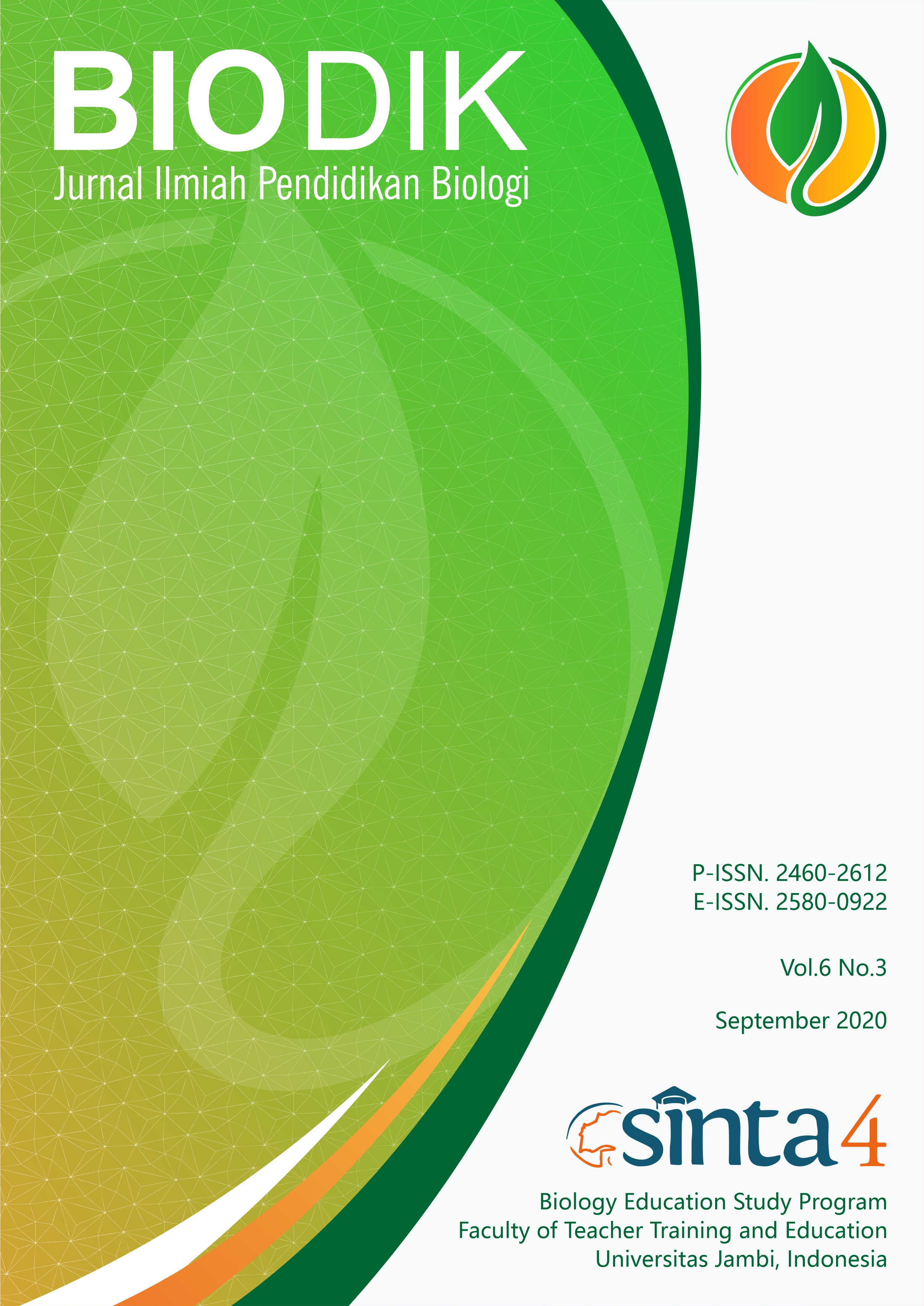Analisis Butir Soal Kemampuan Tree Thinking Pada Instrumen Uji Coba Materi Spermathophyta
(Analysis of tree thinking ability problem ability in spermathophyta trial material instruments)
DOI:
https://doi.org/10.22437/bio.v6i3.9907Keywords:
Kata Kunci: Butir soal, Tree Thinking, Validitas soal, Daya pembeda, dan Kesukaran soalAbstract
This study aims to analyze the ability of Tree Thinking in students. This type of research is quantitative descriptive, the instrument used in the form of test items on Tree Thinking items on Spermatophyta material. This item is a multiple choice with 5 options. The results of this study are information in the form of item validity, distinguishing features, and level of difficulty of the questions. The results of the analysis show the quality of the items, valid at 95% while those that are not valid at 5%. Based on the ability to distinguish the questions, 10% is considered satisfactory, 50% is categorized as good and 40% is categorized as very good. Difficulties about the data obtained are 85% in the medium category, and 15% are in the difficult category. Data analysis shows that the item has a high validity while the distinguishing power is classified as good and the level of difficulty of the item is classified as moderate.
Abstrak. Analisis kemampuan Tree Thinking pada siswa dilakukan menggunakan metode deskriptif kualitatif. Instrumen yang digunakan berupa hasil tes butir soal Tree Thinking pada materi Spermatophyta. Butir soal ini berupa pilihan ganda dengan 5 opsi. Objek yang diteliti adalah 20 butir soal pilihan ganda yang di ujikan pada kelas XI. Hasil dari penelitian ini adalah informasi berupa validitas butir soal, daya pembeda, dan tingkat kesukaran soal. Hasil analisis menunjukkan kualitas butir soal, yang valid sebesar 95% sedangkan yang tidak valid sebesar 5%. Berdasarkan daya pembeda soal menunjukkan 10% dikategorikan memuaskan, 50% dikategorikan baik dan 40% dikategorikan sangat baik. Kesukaran soal data yang di dapat yaitu 85% berada pada kategori sedang, dan 15% berada pada kategori sukar. Analisis data menunjukkan bahwa butir soal memiliki validitas tinggi sedangkan daya pembeda tergolong baik dan tingkat kesukaran soal tergolong sedang.
Downloads
References
Anwar, Suroyo. (2009). Pemahaman Individu, Observasi, Checklist, Interview,. Kuesioner dan Sosiometri. Yogyakarta: Pustaka Pelajar.
Arikunto, S. (2008). Dasar-dasar Evaluasi Pendidikan. Jakarta: Bumi Aksara
Arikunto, S., (2009). Prosedur Penelitian Suatu Pendekatan Praktik. Edisi Revisi 6. Jakarta : Rineka Cipta.
Arikunto, Suharsimi. (2012). Prosedur Penelitian.Jakarta:n Rineka Cipta.
Azmi, M. P. (2019). Analisis Pengembangan Tes Kemampuan Analogi Matematis pada Materi Segi Empat. JURING (Journal for Research in Mathematics Learning), 2(2), 099. https://doi.org/10.24014/juring.v2i2.7490.
Baum,D.A. & Smith, S.D. (2013). Tree Thinking An Introduction To Phylogenetic Biology. United states: Roberts and Company Publisher, Inc.
Brinkman,F. & Leipe D. (2001). “Philogenetic Analysis, A Practical Guide to the Analisys of Gene and Proteinâ€. Baxevanis,5 (2), hlm. 323-358.
Budiyono.2003. Metodologi Penelitian Pendidikan. Surakarta: UNS Press.
Mahbubah, H. G., Hidayat, T., & Supriatno, B. (2017). Plant vs. Animal, Which is the Most Prefer Understanding of Evolution? International Journal of Science and Applied Science: Conference Series, 2(1), 156.
Mardapi, Djemari. (2012). Pengukuran, Penilaian, dan Evaluasi Pendidikan. Yogyakarta. Nuha Medika.
Mudjijo, (1995). Tes Hasil Belajar, Jakarta: Bumi Aksara.
Novick, L.& Catley, K. (2012). Reasoning about Evolution’s Grad Pttes: College Students’ Understanding of The Tree of life.American Educational Research Journal, 20(10),hlm 1-40.
Novick, L.& Catley, K. (2013). Reasoning about Evolution’s Grad Pttes: College Students’ Understanding of The Tree of life.American Educational Research Journal, 40(1), 138-177.
Permendikbud. (2016). Kompetensi Inti dan Kompetensi Dasar Sekolah Menengah Atas/Madrasah Aliyah (SMA/MA). Jakarta: Kementrian Pendidikan dan Kebudayaan.
Rustaman, N. (1991). Klasifikasi Makhluk Hidup dalam materi pokok Pendidikan IPA 1. Jakarta: Depdikbud.
Sari, A. P. (2019). Analisis Kemampuan Tree Thinking dan Hubungan dengan Penguasaan Konsep Siswa pada Materi Tumbuhan Biji. Skripsi. Tidak Diterbitkan.
Sugiyono.(2012). Metode Penelitian Kuantitatif Kualitatif dan R&D. Bandung: Alfabeta.
Sulistyorini,2009. Evaluasi Pendidikan Dalam Meningkatkan Mutu Pendidikan,Yogyakarta: TERAS.
Supandi, S., & Farikhah, L. (2016). Analisis Butir Soal Matematika Pada Instrumen Uji Coba Materi Segitiga. JIPMat, 1(1), 71–78.
Surapranata Sumarna. (2005). Analisis, Validitas, Reliabilitas dan Interpretasi Hasil Tes, Implementasi Kurikulum 2004. Bandung: Remaja Rosdakarya.
Downloads
Published
Versions
- 2020-10-09 (3)
- 2020-10-09 (2)
- 2020-09-10 (1)
How to Cite
Issue
Section
License
Copyright (c) 2020 Utami Khofifah, Jujun Ratnasari, Aa Juhanda

This work is licensed under a Creative Commons Attribution-NonCommercial-ShareAlike 4.0 International License.
Copyright Notice
Authors who publish with Biodik : Jurnal Ilmiah Pendidikan Biologi agree to the following terms:
- For all articles published in Biodik : Jurnal Ilmiah Pendidikan Biologi, copyright is retained by the authors and grant the journal right of first publication with the work simultaneously licensed under a Creative Commons Attribution-ShareAlike 4.0 International Licensethat allows others to share the work with an acknowledgment of the work's authorship and initial publication in this journal.
- Authors are able to enter into separate, additional contractual arrangements for the non-exclusive distribution of the journal's published version of the work (e.g., post it to an institutional repository or publish it in a book), with an acknowledgment of its initial publication in this journal.
- Authors are permitted and encouraged to post their work online (e.g., in institutional repositories or on their website) prior to and during the submission process, as it can lead to productive exchanges, as well as earlier and greater citation of published work (See The Effect of Open Access).
















